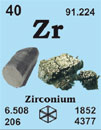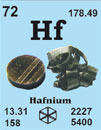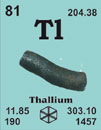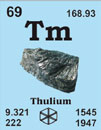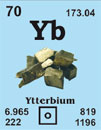Blei 82Pb207.19
In alten Kulturen bekannt.
French: plomb
German: blei
Italian: piombo
Spanish: plomo
Beschreibung: Weiches, duktiles, mattgraues Metall. Läuft in feuchter Luft an, aber ist gegen Sauerstoff und Wasser beständig, löst sich in Salpetersäure. Verwendet für Akkumulatoren, Kabel, Farben, Glas, Lot, Benzin und zum Strahlenschutz.
Blei single crystal properties
| State: |
single crystal |
|---|
| Crystal structure: |
fcc |
|---|
| Production method: |
Bridgman |
|---|
| Standard size: |
diameter 10-12mm
thickness 1-2mm |
|---|
| Orientation: |
(100), (110) and (111) |
|---|
| Orientation accuracy: |
<2°, <1°, <0.4° or <0.1° |
|---|
| Polishing: |
electrochemical |
|---|
| Roughness of surface: |
<0.03µm |
|---|
| Purity: |
99.99% |
|---|
| Typical analysis (ppm): |
C 3
H < 1
O 9
N < 5
Cu 1.60
Fe 1.80
Ni < 1
Pb 0.30
Si 0.30
Ga, Hf and Ta are below the detection limit
|
|---|
Materials properties
| Density: |
11.4 g/cm3 |
|---|
| Melting point: |
327.50 °C / 600.65 °K |
|---|
| Boiling point: |
1739.85 °C / 2013 °K |
|---|
| Molar volume: |
18.26 cm3 |
|---|
| Thermal conductivity: |
35.3 [300 K] Wm-1K-1 |
|---|
| Coefficient of linear thermal expansion: |
29.1 x 10-6 K-1 |
|---|
| Electrical resistivity: |
20.648x 10-8 [293 K] Wm |
|---|
| Mass magnetic susceptibility: |
-1.39 x 10-9(s) kg-1m3 |
|---|
| Young's modulus: |
16.1 GPa |
|---|
| Rigidity modulus: |
5.59 GPa |
|---|
| Bulk modulus: |
45.8 GPa |
|---|
| Poisson's ratio: |
0.44 GPa |
|---|
| Radii: |
Pb4+ 84; Pb2+ 132; atomic 175; covalent 154 |
|---|
| Electronegativity: |
2.33 (Pauling); 1.55 (Allred); 3.90 eV (absolute) |
|---|
| Effective nuclear charge: |
5.65 (Slater); 12.39 (Clementi); 15.33 (Froese-Fischer) |
|---|
| Number of Isotopes (incl. nuclear isomers): |
41 |
|---|
| Issotope mass range: |
184 -> 214 |
|---|
| Crystal structure, (cell dimentions / pm), space group |
fcc |
|---|
| X-ray diffraction: mass absorption coefficients: |
CuKα 232 (µ/r) / cm2g-1
MoKα 120 (µ/r) / cm2g-1 |
|---|
| Neutron scattering length: |
0.9405 b/10-12 cm |
|---|
| Thermal neutron capture cross-section: |
0.171 sa / barns |
|---|
Biological data
| Biological role: |
none |
|---|
| Toxicity |
|
|---|
| Toxic intake: |
c. 50 mg - 100 g |
|---|
| Lethal intake: |
LD50 (acetate, intravenous, mouse)=104 mg kg-1 |
|---|
| Hazards: |
Lead is moderately toxic by ingestion and affects the gut and central nervous system and causes anaemia. However, most ingested lead passes through the body without being absorbed. It is a cumulative |
|---|
| Level in humans |
|
|---|
| Blood: |
0.21 mg dm-3 |
|---|
| Bone: |
3.6 - 30 p.p.m. |
|---|
| Liver: |
3 - 12 p.p.m. |
|---|
| Muscle: |
0.23 - 3.3 p.p.m. |
|---|
| Daily dietary intake: |
0.06 - 0.5 mg |
|---|
| Total mass of element in average [70 kg] person: |
120 mg (stored in skeleton) |
|---|
Geological data
| Mineral | Formula | Density | Hardness | Crystal apperance |
|---|
| Anglesite |
PbSO4 |
6.38 |
2.5 - 3 |
orth., adam./greasy white |
|---|
| Boulangerite |
Pb5Sb4S11 |
6.23 |
2.5 - 3 |
orth., met. bluish-grey |
|---|
| Bournonite |
PbCuSbS3 |
5.8 |
2.5 - 3 |
orth., met. steel-grey |
|---|
| Cerussite |
PbCO3 |
6.55 |
3 - 3.5 |
orth., adam./vit. Col. |
|---|
| Galena |
PbS |
7.58 |
2.6 |
cub., met. grey |
|---|
| Minium |
Pb3O4 |
9.05 |
2.5 |
tet., greasy red/brown |
|---|
| Pyromorphite |
Pb5(PO4)3Cl |
7.04 |
3.5 - 4 |
hex., barrel-shaped crystals, often hollow |
|---|
| Chief ore: |
galena is the main ore (with silver as a by-product), pyromorphite, boulangerite and cerussite are m |
|---|
| World production: |
2.8 x 106 tonnes/year |
|---|
| Main mining areas: |
galena in USA, Australia, Mexico, West Germany; boulangerite in France. |
|---|
| Reserves: |
85 x 106 tonnes |
|---|
| Specimen: |
available as foil, granules, ingots, powder, rod, shot and wire. CARE ! |
|---|
| Abundances |
|
|---|
| Sun: |
85.1 (relative to H = 1 x 1012) |
|---|
| Earth's crust: |
14 p.p.m. |
|---|
| Seawater: |
|
|---|
| Residence time: |
|
|---|
| Classification: |
scavenged |
|---|
| Oxidation state: |
II |
|---|

 English
English
 Deutsch
Deutsch








































